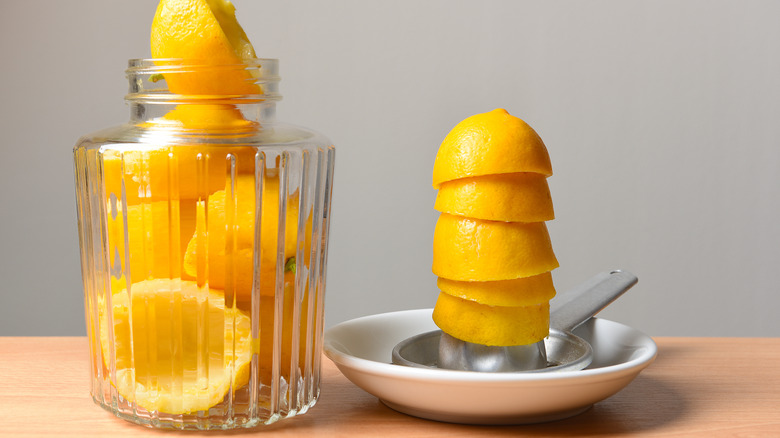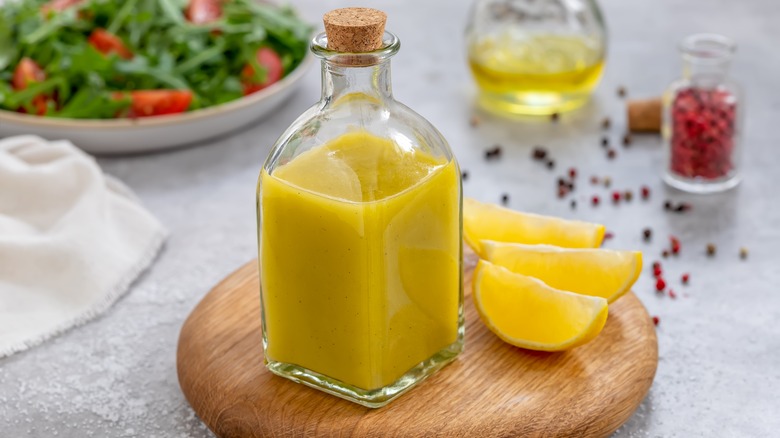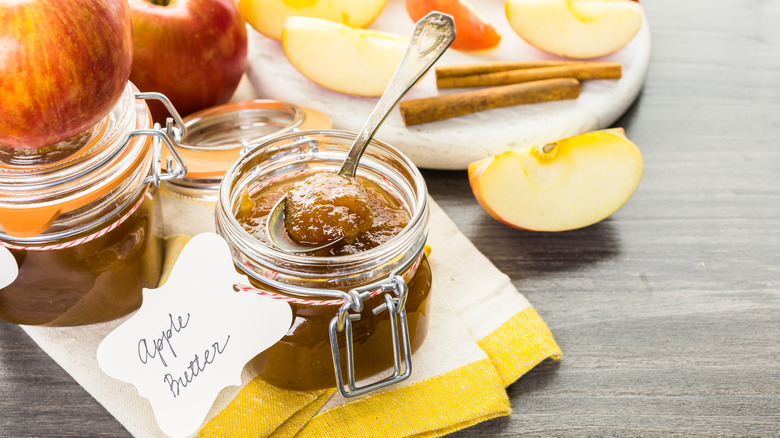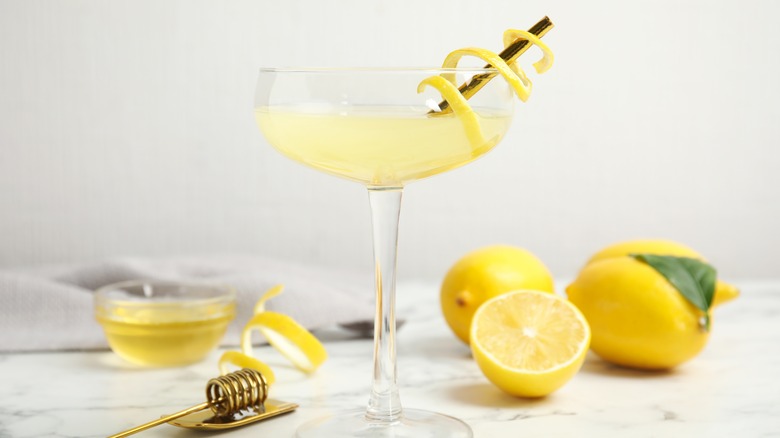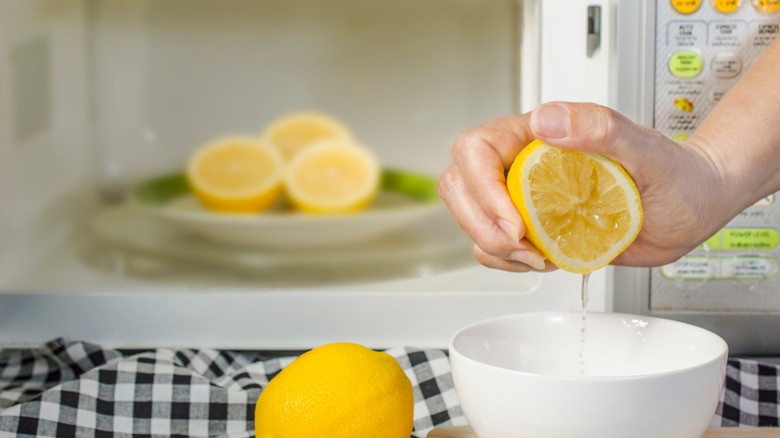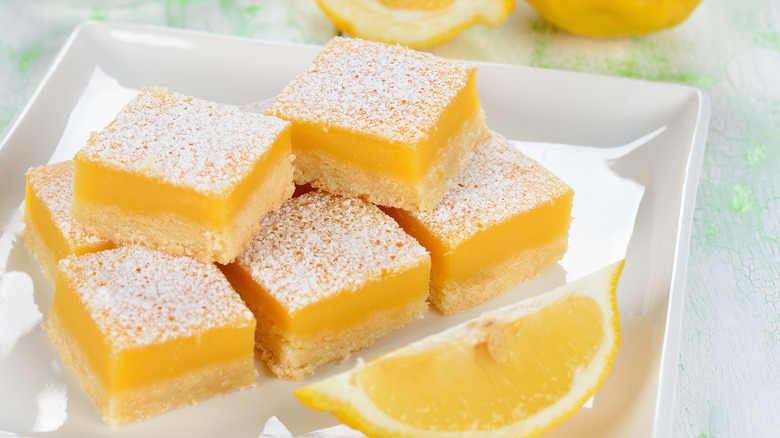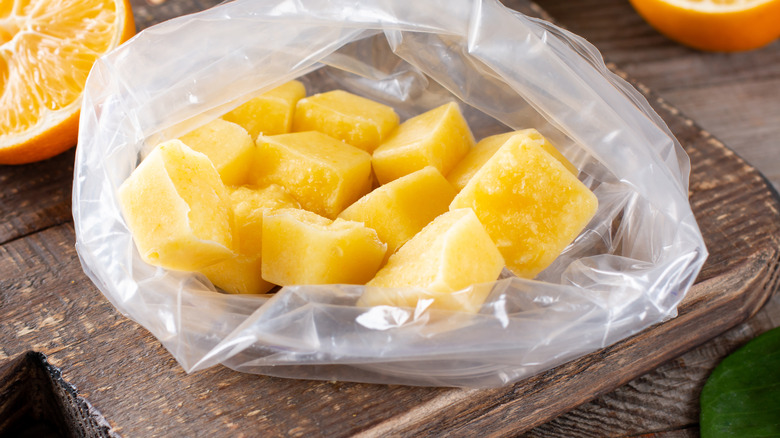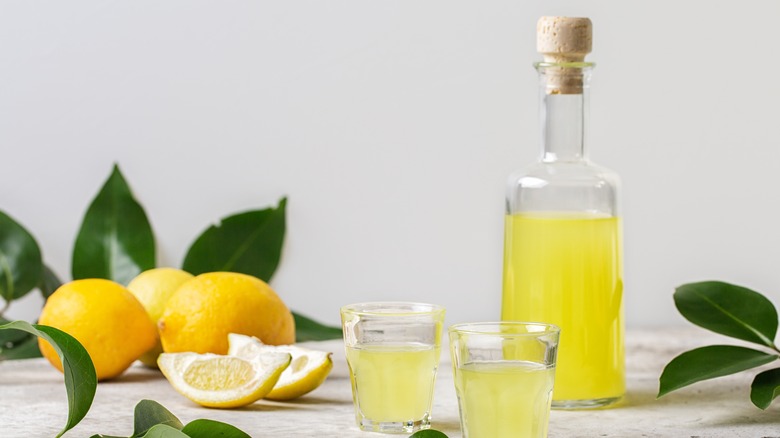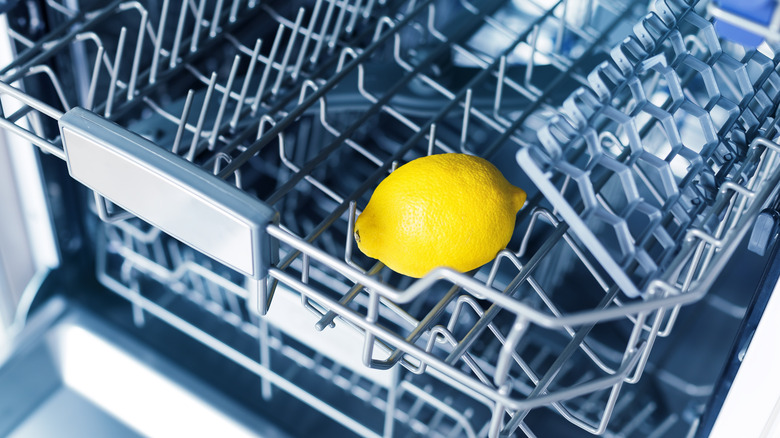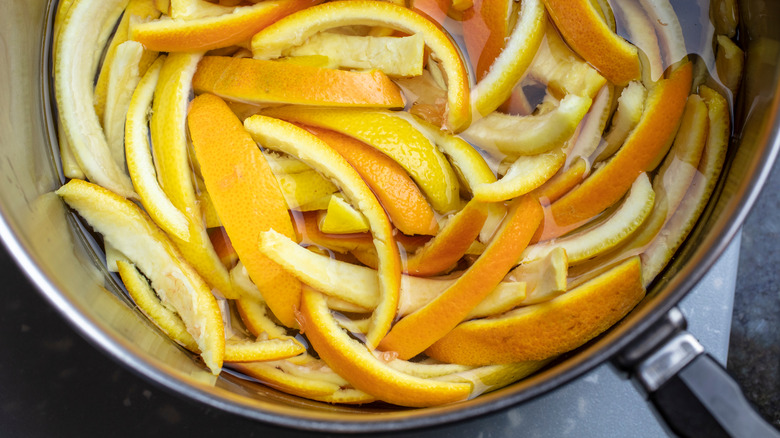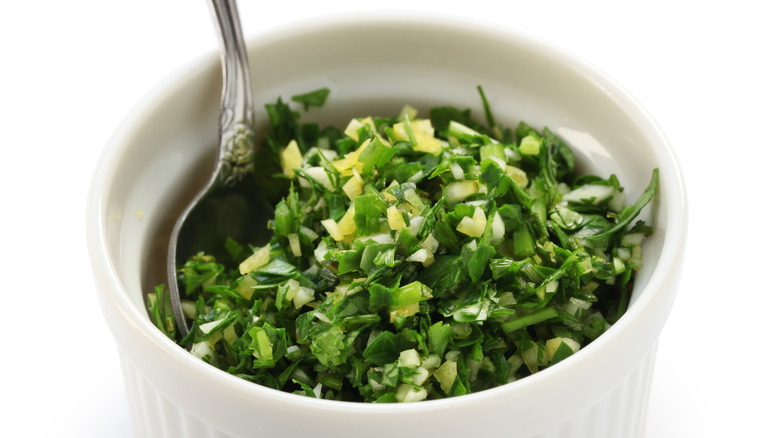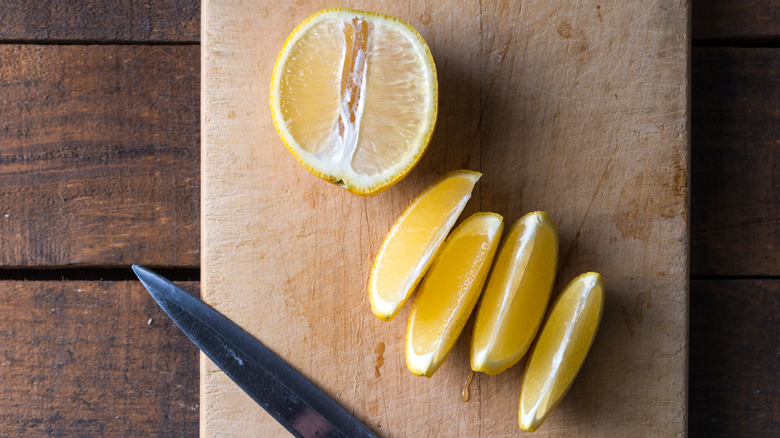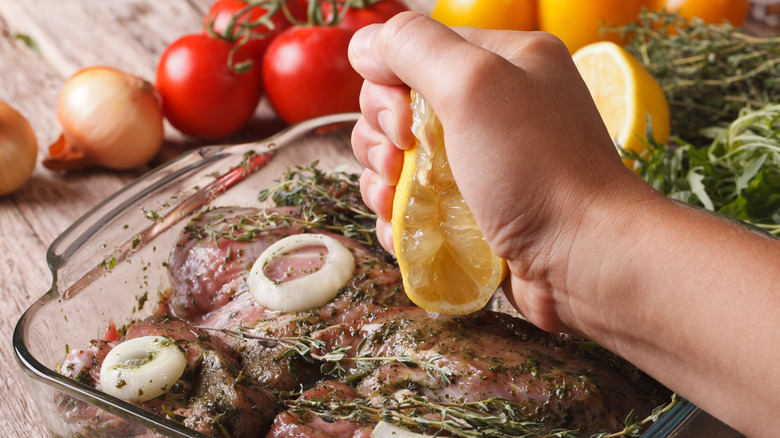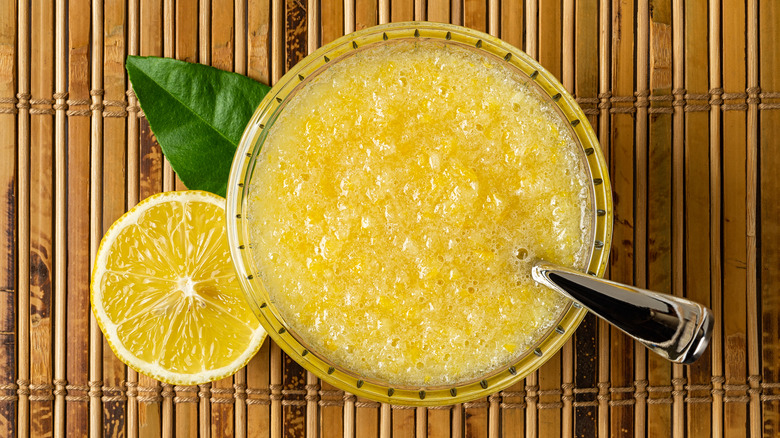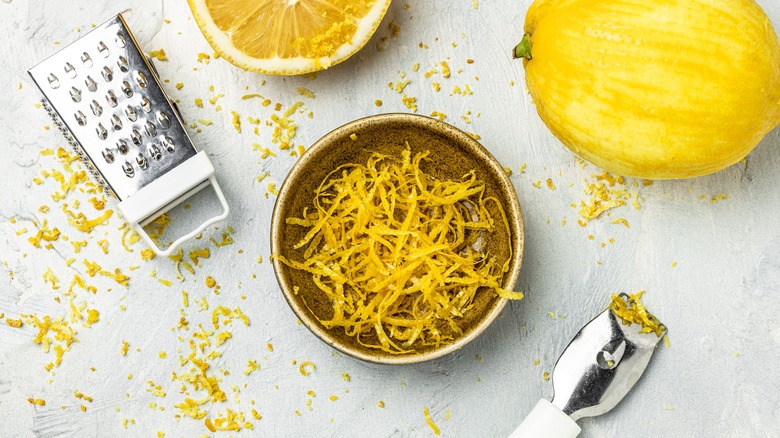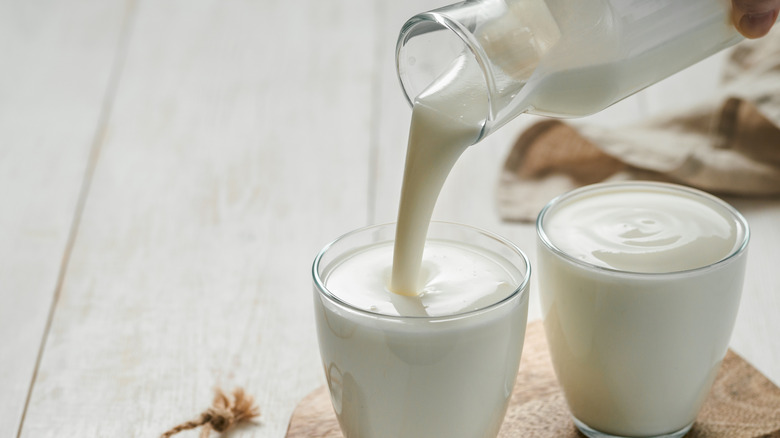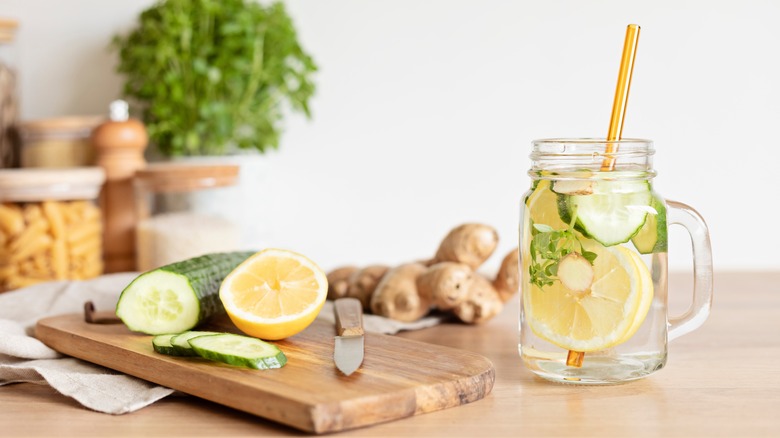Clever Things You Can Do With Leftover Lemons In The Kitchen
Lemons are a giant when it comes to kitchen staples. They lend their brightly colored peel and distinctive tangy flavor to so many dishes, both savory and sweet. Yet much of the flesh of these beautiful fruits can often end up in the bin after the juice has been used in a recipe. While your intentions might be good — think: fresh lemonade or a citrus-based dessert – it's not uncommon to have an abundance of (whole) lemons languishing in a bowl on the counter or halved and quartered at the bottom drawer of the refrigerator.
And every day, you look at those lemons and watch as they go from bad to worse. Before throwing leftover lemons on the compost heap, however, consider putting them to use in a multitude of clever ways. From cleaning your kitchen to feeding flowers, let's uncover resourceful methods to utilize every part of your old-ish lemons, reducing food waste and enhancing your culinary repertoire.
Make a lemony dressing
A healthy salad deserves dressing that will elevate it to a higher level. Store-bought dressings are often full of unhealthy ingredients and can never compare to homemade, and with a few leftover lemons from your fridge, a fresh, piquant dressing is moments away.
The first step in making your citrus dressing is to juice the lemon. If your lemon has gone hard from being in the fridge for a while, roll it firmly on the chopping board with your hand for at least 10 seconds. This will break the membranes inside, releasing more juice when you cut it open.
Grate some zest from the lemon too, and add it to the juice before slowly whisking in some extra-virgin olive oil. As you whisk, the liquid will become thick and velvety — the perfect viscosity to cling to those vibrant salad leaves. Add seasonings such as salt and pepper, dried herbs, and even some raw garlic or mustard if you want a punchy flavor.
Drizzle over your salad and enjoy the refreshing zing that lemons can add to your midweek salad. In fact, this dressing can be used to top any grilled vegetables or even a pasta dish and will keep for up to five days in the fridge, meaning you can liven up your veggies for the whole week.
Use lemons to stuff chicken
If you are planning to make a roast chicken for your Sunday dinner — or any other day of the week — try using leftover lemons to flavor the meat as it cooks. Stuffing a bird with lemon has two benefits — the citrusy flavor will infuse into the chicken, and the moisture will keep the meat tender and juicy.
To prepare the meat, cover the skin with olive oil and season generously. Cut the lemon in half, place half inside the cavity, and squeeze the other liberally over the skin. If you want a slightly more unusual way to impart the lemon flavor to your roast, try Jamie Oliver's tip — he boils the lemon with the potatoes, then stabs the flesh and immediately stuffs it into the chicken cavity. The hot lemon juice will add depth of flavor to the chicken flesh; be careful not to scald yourself in the process.
After the chicken has cooked, you can go one step further by removing the lemons and squeezing the remaining juice over the vegetables and potatoes to amp up their flavor with the caramelized lemon juice. The juices from the chicken and the lemon will have collected at the bottom of the pan to create a decadent sauce. If you wish, you can turn this into a more substantial gravy by adding some white wine, onions, and butter and simmering in the pan until thickened.
Make apple butter
If you are looking for a way to turn your leftover lemons into a comforting treat, including them in homemade apple butter is the perfect choice. This indulgent spread has notes of autumn running through it, and adding lemon into the mix will lift the taste and create a symphony of sweet and sour flavors. The addition of lemon gives the apple butter marmalade-like qualities, meaning it can be spread on toast, used in baked goods, or simply eaten straight from the spoon.
To make your citrusy apple butter, chop the apples (you can leave the skins on) and add the juice of half a lemon to a pot with cinnamon and sugar. You can also add lemon zest for a fragrant citrus flavor. Simmer for around two hours, then blend until smooth when it has cooled.
Once it has a buttery texture, scoop it into a jar and keep in the fridge for up to a week — though likely it will all be eaten before then. Add it to bread and pancakes, or use it in overnight oats for a delicious breakfast.
Make your own flower food
Before binning your past-their-best lemons, bear in mind that you could use them to delay throwing away another plant-based feature of your kitchen — your bouquet of flowers. Cut flowers will last longer when given a bit of nourishment, and although commercial flower food is available, you can create an all-natural food in minutes using those leftover lemons.
All you need is 2 tablespoons lemon juice, 1 tablespoon sugar, and ¼ teaspoon bleach mixed with 1 quart of water. The citric acid from the lemon juice creates a more suitable, lower pH environment for the flowers, in addition to having an antibacterial effect. The sugar nourishes the flowers, while the small amount of bleach keeps away harmful microbes.
This homemade flower food is ideal if you are picking flowers from your own garden, if your bouquet did not come with a sachet of food, or if you would rather use a natural option from your own kitchen. By using leftover lemons to feed your flowers, you're living more sustainably and reducing the use of single-use plastic.
Dry lemon peel for drinks and other things
Before you sip your favorite drink, stop to consider what it may be missing. Whether it's a chilled glass of sparkling water, a warming cup of herbal tea, or a sophisticated cocktail, a touch of citrus might elevate it to the next level. Making dried lemon peel from leftover lemons will allow you to have your soon-to-be favorite garnish on hand whenever you need it.
If you thought drying lemon peel would require fancy equipment like a dehydrator, think again. Citrus peel can be dried in the oven or even on a countertop if the room temperature is warm enough. The smaller the zest, the faster it will dry — bear that in mind if you're short on time.
The lemon peel can either be grated using a cheese grater or a lemon zester, both of which will give small shavings — or it can be peeled in long strips using a vegetable peeler. Finely grated zest will dry out in the oven within 30 minutes, whereas strips of peel will take a few hours. To air dry in the house, leave the peel in a sunny spot, if possible, and shake regularly to stop them from sticking together. They should dry out within a few days. Once you have your dried lemon peel, you can add it to drinks, sauces, and even dishes such as oatmeal or pasta.
Clean the microwave
The microwave is such a reliable appliance, always on hand to prepare a quick meal or heat up last night's leftovers. But for some reason, cleaning the microwave is a much-hated job, on par with unclogging the sink or scrubbing tiles. Food spatters in the most awkward places in microwaves, and the lingering odors can be unpleasant.
Keeping the microwave in tip-top shape is easier if you stay on top of it rather than pushing it to the bottom of your to-do list. Leftover lemons can turn this dreaded chore into a breeze and have your microwave looking and smelling fresh in no time. The acid in the lemons breaks down grease, and the scent from citrus neutralizes nasty smells. Using lemons as a way to naturally clean your kitchen means avoiding harsh chemicals that could pose a threat to the health of your family.
Cleaning your microwave with leftover lemons doesn't have to be a chore — it's pretty straightforward: Half-fill a microwave-safe bowl with water, then cut the lemon in half and squeeze the juice into the water. Next, you'll add the lemon halves to the bowl and microwave for three minutes. Keep the microwave door closed for five minutes to allow the steam to do its job. Finally, remove the bowl of lemons and wipe down the inside of the microwave with a cloth. Done! And now you also have the peace of mind that comes from using natural cleaners instead of synthetic ones.
Make lemon bars
Though lemons are famous for being sour and tangy, they can enhance desserts and sweet treats when combined with the perfect amount of sugar. With the addition of a few pantry staples, those leftover lemons on your counter can be transformed into a delightful and refreshing dessert after a midweek meal.
Lemon bars, for example, with their buttery shortbread base and bright lemon curd filling, are a great example of how sweet and sour come together to create a mouthwatering delicacy. Making delicious lemon bars requires minimal time and effort and will allow you to make the most of your aging lemons.
But if lemon bars aren't your thing, whip up a lemon curd and use it to make a lemon fool, lemon crumble, or a lemon Swiss roll. With a variety of sweet options at your fingertips, using leftover lemons in your scrumptious treats will be a joy. And yes, it's pretty clever, since you're cutting down on food waste and indulging your tastebuds simultaneously. It's a win-win!
Freeze lemon juice in ice cube trays
Having some lemons on hand to freshly squeeze juice into drinks and sauces is crucial for any aspiring chef. It's frustrating to open the refrigerator mid-recipe and realize that you used the final lemon for last week's gin and tonic. But there is a way to always have lemon juice available whenever you need it — hello, freezer!
Create a stock of lemon juice by freezing the juice of your leftover lemons in ice cube trays, ready to use at a moment's notice. Start by prepping your leftover lemons to make sure you get as much juice as possible. Soft lemons will yield more juice, and lemons that are past their prime have a tendency to be quite hard — you can soften those by heating them up, either in a bowl of hot (not boiling) water for 30 minutes or by putting the whole lemon in the microwave for 20 seconds.
Once you have juiced your lemons, pour the juice into an ice cube tray. You can add fresh herbs or chopped fruit to some of the cubes if you want to infuse different flavors. After freezing for a few hours or overnight, empty the ice cubes into a freezer bag and repeat the process until you have used up all your leftover lemons. You will now have a stock of frozen lemon juice at your disposal, ready to throw into a cocktail, iced tea, or homemade curry.
Make limoncello
Who doesn't love limoncello — the silky, zesty Italian liqueur that takes you to the shores of the Amalfi coast with one delicious sip? Its sweet but tart flavor is enjoyed as a classic after-dinner digestif, and it can be purchased at many liquor stores. But have you considered making your own? Those leftover lemons in your fridge may be the perfect opportunity to embark on a culinary adventure right in your kitchen. You will need to be patient between bottling the limoncello and drinking it — and trust us, it's worth the wait!
The basic ingredients for homemade limoncello are lemon rinds, vodka, and agave or sugar syrup. The quantities of each will depend on how many lemons you have. If you want to make a large batch of limoncello, you can freeze the lemon rind (peels) whenever you have lemons to spare and make the liqueur once you have the rind of 10 lemons. Add the peels of the 10 lemons to 750 milliliters of vodka (almost any glass jar or bottle you can secure at the top will work) and leave to infuse for a few days if you want a mild version — up to a month for a very strong flavor. Once it has infused, strain the liquid and add the syrup to finish off the limoncello.
For an authentic experience, chill the limoncello in the freezer for a few hours before serving. Cold limoncello will have a thicker, more luxurious texture, providing a cool, zesty sensation with every flavorful sip.
Add to the dishwasher
While many of these hacks are great for using whole leftover lemons, this next clever tip puts to use lemons that have already been juiced and zested and are destined for the bin. While you may think you have made great use of your lemons in the recipe you are making, there is still life in them yet. Instead of chucking them in the compost bin, throw them in the dishwasher. The citric acid in the lemon can cut through grease and make your dishes shine a little brighter, as well as create a lovely, natural, lemony smell in the kitchen. Just be sure to place them in the cutlery rack to make sure they don't get clogged in a filter.
Another excellent way to put this concept to use is when you don't have access to running water — at a picnic, for instance. Pack a lemon, and having used it to season your food, rub it across your dishes after you've finished eating to clean the grease before putting them into your basket.
Make candied lemon peel
Though lemons are mostly used for their juice, the peel has just as much potential and can be used in a number of innovative ways. If you've ever tasted candied lemon peel, you will understand just how fabulous that citrus skin can be. Time to transform those leftover lemons into decadent crystalline treats.
Begin by peeling your lemons either with a lemon zester or a vegetable peeler, depending on what size you want your candied treats to be. Take care to include as much of the zest as possible without any of the bitter white pith. Blanch the lemon peels in boiling water, then drain, repeating this process two or three times to remove as much bitterness as possible. Then simmer in sugar and water (roughly 2 cups each) for around 15 minutes. Remove the peels from the syrup and let them dry — then toss in a bowl of sugar until they are well coated. Your leftover lemon peels have now become sparkling, chewy treats.
Candied lemon peels can be used to top cakes, as garnish for cocktails, and even to add tart sweetness to savory dishes such as salads. The beauty is that once you have peeled your lemons, you can still use the juice in other dishes.
Make gremolata
Italians are the masters of taking simple ingredients and transforming them into delicious concoctions, and they particularly excel when it comes to fresh produce. Gremolata is an example of such a dish, and it is a delicious way to use leftover lemons.
A basic gremolata has only three ingredients — lemon, garlic, and parsley. The fresh, earthy parsley complements the strong flavors of the lemon and garlic to create a dressing that is fresh and zingy. It is often used to accompany braised meat, traditionally osso buco, but it goes wonderfully with fish and pasta as well.
To prepare the gremolata, finely chop both the garlic and parsley and zest the lemon. You can add lemon juice to the mix, or just go with the zest. Mix all ingredients in a bowl, or pound together in a mortar and pestle to create a paste. Use the gremolata straight away to benefit from its freshness, or store it in an airtight container in the fridge for a week.
While this is the classic Italian gremolata, you can mix it up depending on what you have in your cupboards. Basil and mint take the flavor in a different direction, or you can add orange zest to contrast the lemon peel. Whatever ingredients you add, you will end up with a bright, flavorsome dressing that will elevate any dish.
Remove stains from the chopping board
One piece of kitchen equipment most of us couldn't cope without is our trusty chopping board. This reliable sidekick bears the brunt of our gastronomic activities on a daily basis and can use some TLC. The good news is you can breathe new life into your wooden chopping board with the help of one of your leftover lemons.
The citric acid in the lemon breaks down grease and stains, and their antibacterial properties mean it should stay cleaner for longer. You also have the advantage that the lemon juice will leave your kitchen smelling fresh for hours. All you need is salt and half a lemon. Rub salt on the board, paying particular attention to any bad stains. Then squeeze lemon juice over it and use the lemon to rub the salt across the board before wiping with a damp cloth.
This natural cleaning method not only allows you to cut down on food waste but also ensures that your board is free from potentially toxic chemicals that are found in many household kitchen cleaners. This cleaning method can be used every few weeks alongside regular washing with hot, soapy water, ensuring that your chopping board will look great, be free from germs, and devoid of stains.
Tenderize meat with a lemon marinade
It turns out the unassuming lemon has yet another string to its bow: It can start to "cook" meat before you even add heat. Though technically cooking requires the application of heat, the process of cooking meat causes the proteins to be denatured, resulting in a change in texture. The citric acid in lemon juice causes the same effect, meaning that marinating meat or fish in lemon juice can begin the tenderizing process before cooking begins.
Marinating steak in lemon juice — or chicken or fish, for that matter — will not only lift the meat with a bright, zingy flavor but will also make the meat more tender, meaning that cooking time can be reduced to lower the likelihood of drying it out. In the Spanish classic ceviche, lemon or lime juice is used to break down the seafood protein, and the fish is not cooked at all. It is worth noting, however, that although lemon juice can denture the proteins, cooking is much more effective at killing bacteria, so marinating is best utilized in conjunction with cooking.
To create a citrus marinade, combine lemon juice (even from older leftover lemons or lemons that have been used for another dish but still have juice left), olive oil, dried herbs, and salt. Coat the meat liberally in the mixture. Leave the meat in the marinade for at least two hours to let the lemons work their magic.
Make lemon purée
The versatility of lemons is what makes them such essential ingredients in our pantry or fridge. From a tangy curry to a sweet, indulgent cake, lemons can lend their amazingness to a huge variety of dishes, and there are very few ingredients they would seem out of place with. While lemon juice is used in so many recipes, another clever culinary trick is to make a purée using leftover lemons.
Creating lemon puree from spare lemons is not only a sustainable approach to minimizing food waste, but it will also allow you to create an ingredient that you can have up your sleeve to elevate dishes. Simply boil your leftover lemon halves in a pot until they soften, blend them up in a food processor, and store the resulting purée in the fridge, ready to make its mark the next time you need to add a bright, zesty flavor to any sweet or savory dish.
The lemon puree will have all the delightful features of lemon juice but without the underlying bitterness. It can be added to fruit desserts or yogurt to give a vitamin-packed zing — or lend its flavor to sauces and dressings for salads. As with lemon juice, purée can be frozen in an ice cube tray to make sure you always have some to liven up your recipes.
Freeze lemon zest
Lemon zest is a wonderful ingredient to have on hand to add a bright and refreshing touch to your cooking. Lemon zest has a more intense flavor than the juice and is great to use in baking and sauces without affecting the volume of liquid. The issue is that often, when a recipe calls for lemon zest, we don't have any lemons in the fridge — yet we use lemons so often for their juice and throw the zest away. The perfect solution to avoid wasting citrus peels is to freeze the zest whenever you have a few lemons on hand, and it will always be ready to use when you need it.
The simplest way to zest a lemon — or any other citrus fruit — is to remove the zest before you cut it open. While it is possible to zest half a lemon, it certainly isn't as easy! Use a dedicated citrus zester or a fine grater to remove the zest, but try not to take too much of the white pith off underneath, which doesn't have as pleasant a flavor.
To prevent the zest from clumping together in the freezer, spread it out onto a baking tray and freeze for an hour before transferring it to a freezer-safe bag. The best thing about frozen zest is there is no need to defrost it; simply chuck it into the dish you are cooking and enjoy the zingy flavors it will add.
Make a buttermilk substitute
If you enjoy baking, buttermilk is likely an ingredient you use often. With its tangy flavor and ability to create a light, airy batter, buttermilk is a key ingredient in pancakes, muffins, and coated fried foods, especially chicken. If you need buttermilk for a recipe but don't have any in the fridge, don't panic — you can whip up a great substitute using simply milk and lemons.
The name buttermilk comes from the fact that it was originally a by-product of churning cream into butter. However, the modern buttermilk that we know and love is produced in a similar way to yogurt by adding Lactococcus lactis or Lactobacillus bulgaricus to milk. These bacteria cause the milk to ferment, creating that distinctive sharp taste.
Adding lemon juice to milk can create a similar tangy flavor thanks to the citric acid present, which also creates carbon dioxide bubbles when mixed with baking soda — a must for a fluffy batter. The good news is that the recipe for this couldn't be easier. Add 1 tablespoon of fresh lemon juice to a cup of full cream milk and leave for 10 minutes to react. You can then use the mixture as a direct substitute for buttermilk in your recipes and never have to miss out on delicious buttermilk chicken again.
Brighten your mornings with lemon water
If you're looking to start each day off on the right foot and be energized for the tasks ahead, having a glass of hot lemon water is supposedly a great way to start. Many health books and programs recommend this since the health claims surrounding lemon water are quite significant — including reducing fatigue, supporting a healthy weight, and even preventing kidney stones.
This is great motivation to start adding a glass of lemon water to your morning routine, but there is one small issue: Many of us are already pressed for time in the morning, and the thought of spending time juicing lemons to add to the water can be enough to make us pass.
To save you a few precious moments in the morning and make it more likely you will actually make the lemon water, try freezing individual portions of lemon juice in advance. Squeeze the juice out of enough lemons to fill an ice cube tray, then freeze and transfer to a plastic bag once they have frozen. This will free up your ice cube tray, allowing you to experiment with different combinations of flavors. You could make honey and lemon juice ice cubes, or lemon and turmeric, or even lemon and mixed herbs. In each case, you can simply grab a couple of ice cubes from the freezer bag first thing in the morning and add them to a glass of boiling water to release their wonderful properties.

